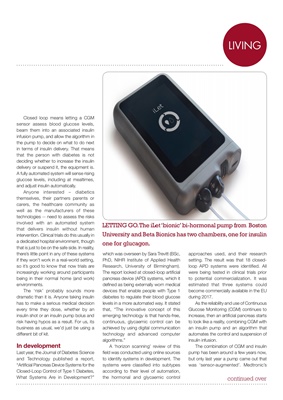
KITLIVING
continued over
LETTING GO. The iLet 'bionic' bi-hormonal pump from Boston
University and Beta Bionics.
Closed loop means letting a CGM
sensor assess blood glucose levels,
beam them into an associated insulin
infusion pump, and allow the algorithm in
the pump to decide on what to do next
in terms of insulin delivery. That means
that the person with diabetes is not
deciding whether to increase the insulin
delivery or suspend it, the equipment is.
A fully automated system will sense rising
glucose levels, including at mealtimes,
and adjust insulin automatically.
Anyone interested - diabetics
themselves, their partners parents or
carers, the healthcare community as
well as the manufacturers of these
technologies -- need to assess the risks
involved with an automated system
that delivers insulin without human
intervention. Clinical trials do this usually in
a dedicated hospital environment, though
that is just to be on the safe side. In reality,
there's little point in any of these systems
if they won't work in a real-world setting,
so it's good to know that now trials are
increasingly working around participants
being in their normal home (and work)
environments.
The 'risk' probably sounds more
dramatic than it is. Anyone taking insulin
has to make a serious medical decision
every time they dose, whether by an
insulin shot or an insulin pump bolus and
risk having hypos as a result. For us, its
business as usual, we'd just be using a
different bit of kit.
In development
Last year, the Journal of Diabetes Science
and Technology published a report,
"Artificial Pancreas Device Systems for the
Closed-Loop Control of Type 1 Diabetes,
What Systems Are in Development?"
which was overseen by Sara Trevitt (BSc,
PhD, NIHR Institute of Applied Health
Research, University of Birmingham).
The report looked at closed-loop artificial
pancreas device (APD) systems, which it
defined as being externally worn medical
devices that enable people with Type 1
diabetes to regulate their blood glucose
levels in a more automated way. It stated
that, "The innovative concept of this
emerging technology is that hands-free,
continuous, glycaemic control can be
achieved by using digital communication
technology and advanced computer
algorithms."
A 'horizon scanning' review of this
field was conducted using online sources
to identify systems in development. The
systems were classified into subtypes
according to their level of automation,
the hormonal and glycaemic control
approaches used, and their research
setting. The result was that 18 closedloop
APD systems were identified. All
were being tested in clinical trials prior
to potential commercialization. It was
estimated that three systems could
become commercially available in the EU
during 2017.
As the reliability and use of Continuous
Glucose Monitoring (CGM) continues to
increase, then an artificial pancreas starts
to look like a reality, combining CGM with
an insulin pump and an algorithm that
automates the control and suspension of
insulin infusion.
The combination of CGM and insulin
pump has been around a few years now,
but only last year a pump came out that